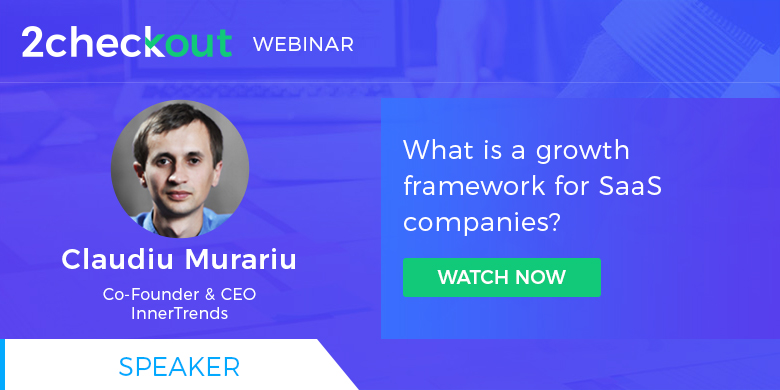Growth is top of mind for most companies, but it can be tricky to get started with developing a growth framework. For one thing, most companies aren’t organized around growth, so thinking about growth requires a lot of collaboration between teams. Additionally, companies often don’t have easy access to all of the data they need to understand growth.
So how can you overcome these challenges and start growing your business?
To truly take your business to the next level, adopting a growth framework will help you evaluate your growth strategy against results and remove any blockers to growth. We recently hosted a webinar with Claudiu Murariu, Co-founder and CEO at data-driven growth experts InnerTrends, on finding your growth framework. Here are a few key concepts to get you started working on a growth mindset—you can watch the whole webinar to finish creating your own growth framework.
Consider the “Growth Equation”
Did you know that most people who sign up for a product don’t spend more than a day with it? Growth hackers use “growth frameworks” to understand what drives increased use of their products. One basic “growth equation” developed by Chamath Palihapitiya, who was charged with leading user growth at Facebook, holds that:
top of funnel x magic moment x core product value = sustainable growth
In other words, you can’t have only a lot of traffic, an a-ha moment or a great product: you need to bring them all together to achieve sustainable growth. A growth framework is what will help you unite all of these elements successfully.
Get the Data You Need
To begin developing your growth framework, you need to gather all the data you need and map it to your business requirements. This data might span mission-critical data, user experience data and any third-party data that can influence your business outcomes. Make sure that you can access this information quickly, easily and on a regular basis, and that you are confident about its accuracy—a growth framework based on inaccurate data can’t succeed. Then, match the data to your business needs.
Take a Holistic View and Prioritize
Your company’s “growth” might stretch across account creation, onboarding, conversion, retention and other areas of focus for the business. Each of these stages in your customers’ interaction with your business provides an opportunity to grow your business. But you can’t fix them all at once. Figure out the biggest problem you face right now, which is also the biggest opportunity for you to grow and tackle that first. Ultimately, you need to optimize the bottom line of your business with the promises that you make to users.
Start with Questions, Not Queries
Once you have your data and priorities in place, keep in mind that the questions you need to answer to grow your business are not data queries, so don’t start with the data and expect to grab insights from it. Poking around in Google Analytics for hours might only make your head swim and leave you without any truly useful insights. Instead, work with your cross-functional growth team to brainstorm the key business questions that you can then aim to answer with data.
Identify the biggest problem with your business: are you low on top-of-funnel prospects? Having trouble converting high traffic to users? Losing too many of your users over time? Whatever your main issues may be, data can help you identify what’s driving them and work toward driving growth. For example, here are some questions that might help you improve customer acquisition:
- What traffic sources drive high-quality leads?
- What is the performance of each marketing channel?
- What is the conversion rate of the signup process?
- What are the paths that people go through during signup?
- What is the influence of the pricing page on the decision to sign up?
Take these questions as inspiration to develop your own.
The Excel Way vs the Data Scientist Way
Not every company has a data scientist, but it’s still possible to create a growth framework without a dedicated expert. To do it “the Excel way,” you’ll need to get the raw data you need from relevant sources and use spreadsheets to analyze it at the account level with tools like VLOOKUP and pivot tables, writing down insights as you go. You don’t have to be an analytics expert to do this, but it can be labor-intensive.
If you’re lucky enough to have a data scientist on staff, keep that person informed of your needs on an ongoing basis so you can get the answers you need.
Just keep in mind that your data scientist isn’t a miracle worker: give them sufficient time to find and analyze data, and don’t expect to get answers back in minutes or even hours. Instead of thinking about the data scientist relationship as transactional, think about it as an ongoing dialogue where you can continue to refine questions and get new insights over time.
We hope this information helps you get started thinking about a growth framework. For more, make sure to watch the full webinar and start skyrocketing your growth.





